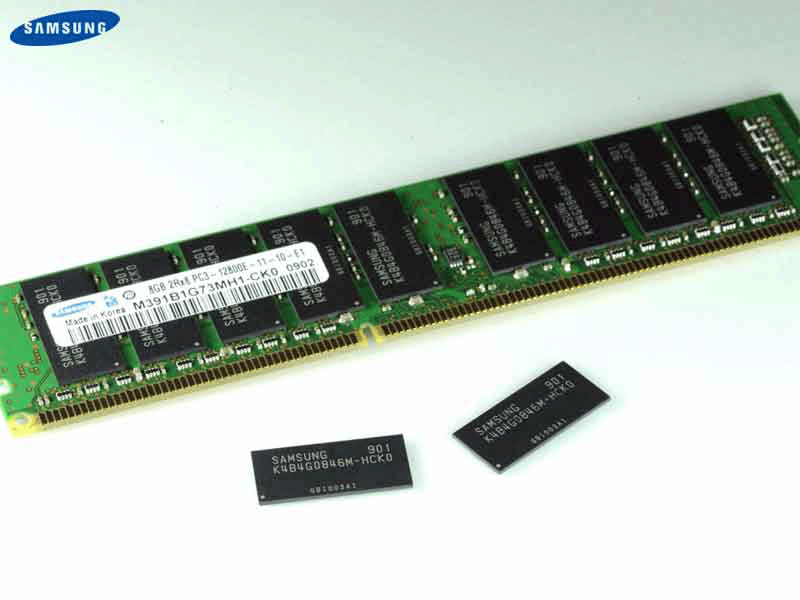DRAM Growth May Slow as Operating Systems Get Leaner
Operating system have been one of the major drivers for DRAM demand, and have experienced an almost persistent boost since the introduction on Windows 95 in 1994 - back then we were asked to upgrade our computers from a modest 4 MB of DRAM to 8 MB.
IHS now says that the trend of quickly growing DRAM demand may come to an end as leaner operating system do not call for rapid increases anymore.
"The growth rate of dynamic random access memory content in personal computers is set for a historic decline, with the average annual increase in DRAM amount for each new PC not expected to exceed 35% after 2012, down from an average 48% during the last quarter-century," IHS said. "After climbing 38% in 2009 and 25% in 2010, average DRAM content per PC will rise 30% in 2011 and 35% in 2012," IHS noted. "The year 2012, however, will represent the last high point for growth, with the amount of annual DRAM content growth in the following years expected to be significantly less than 35%." IHS said that DRAM growth per PC was 48% between 1985 and 2009 and ranged from 40 to 45% in the early 2000s.
The market research firm stressed that, historically, each new version of Windows demanded more memory, but that pattern broke with Windows 7: "From Windows 7’s release in 2009 until a year later, DRAM content growth per PC actually dropped 13% - auguring the kind of lower expansion rates likely to be seen in the years to come."
Microsoft already said that Windows 8 will not have hardware requirements that exceed Windows 7's requirements. Instead of operating systems, it appears that memory drivers will be shifting to more computing devices as well as applications, which would include more applications running at the same time as well as increased use of multimedia.
"As the appetite for digital data swells continually among consumers, so too will the memory requirements needed to feed the ravening beast," IHS said.
Get Tom's Hardware's best news and in-depth reviews, straight to your inbox.

Douglas Perry was a freelance writer for Tom's Hardware covering semiconductors, storage technology, quantum computing, and processor power delivery. He has authored several books and is currently an editor for The Oregonian/OregonLive.
-
Applications or "games" should absorb memory not an OS as eye candy it might be. Also isn't it possible to make solid state HD's out of DRAM. There is always a need for faster memory especially for the upcoming cpu's.Reply
-
schmich It's a bit the point of the article but it doesn't matter if the DRAM growth is slowed. The article talks about the OS but also DRAM is cheap and most of us have quite a few slots to fill. Most gamers hanging around 8GB I'd assume which is enough to get rid of the Page File and run games.Reply -
demonicrotato luc vrApplications or "games" should absorb memory not an OS as eye candy it might be. Also isn't it possible to make solid state HD's out of DRAM. There is always a need for faster memory especially for the upcoming cpu's.Reply
They could make HDs out of DRAM. The problem is that DRAM is volatile and doesn't retain information once the power is turned off. So say good by to whatever data you put on there. -
bak0n demonicrotatoThey could make HDs out of DRAM. The problem is that DRAM is volatile and doesn't retain information once the power is turned off. So say good by to whatever data you put on there.Reply
Notice he said solid state HD, not ram drives. -
mister g Eventually the tech companies are going to put out new OSs that need more and more RAM to function. In my opinion this is a temporary lull and growth would start again many people shouldn't see a reason not to upgrade with RAM prices as low as today.Reply -
palladin9479 The fallacy of this article is that it assumes only the OS is going to be using memory. This is bullocks as if you have a ton of memory laying around you can easily create a large RAMDISK and use that for scratch area. I had 8GB (now have 16GB) and would create a 1GB RAMDISK as my "V:" drive inside Windows 7. I would then redirect the %WIN_DIR%\TEMP and the users TMP / TEMP folders to the V drive. Performance impact is incredibly noticeable when installing programs, browsing the internet, or just mucking around on some project or other. I've been debating making a larger RAMDISK and redirecting certain data folders on some of my games to there. Windows doesn't yet have the facility to properly utilize this function, I have to use third party programs to get this done.Reply -
ta152h This is insulting to Microsoft.Reply
Microsoft has been able to over 30 years to increase memory use (and processor use) without increasing functionality in a seamless and elegant way. They even convinced people that Windows 7 was faster and leaner than Windows Vista, even though all tests showed otherwise. Even the great Jobs has yet to accomplish this act of "I'll tell you the truth, forget what you think you see".
It's a common ploy for OS manufacturers to say requirements aren't going up, but then the thing doesn't work quite as well, and recommended requirements are a bit higher.
Give Microsoft some respect. Windows 8 will be slower and require more memory without doing anything extra that anyone finds useful. They've done it for years, and to expect otherwise is simply insulting to Microsoft's ability to bloat and slow down. While there's a saying in the industry that Microsoft has sold more processors than Intel marketing, I think it's also fair to say they've sold more memory than any memory makers marketing.
Have faith, they will continue to. Taking billions of bytes of memory without added functionality is a talent. Selling it in numbers, worthy of great respect. Don't count them out. -
dragonsqrrl TA152HThey even convinced people that Windows 7 was faster and leaner than Windows Vista, even though all tests showed otherwise.Source?Reply
